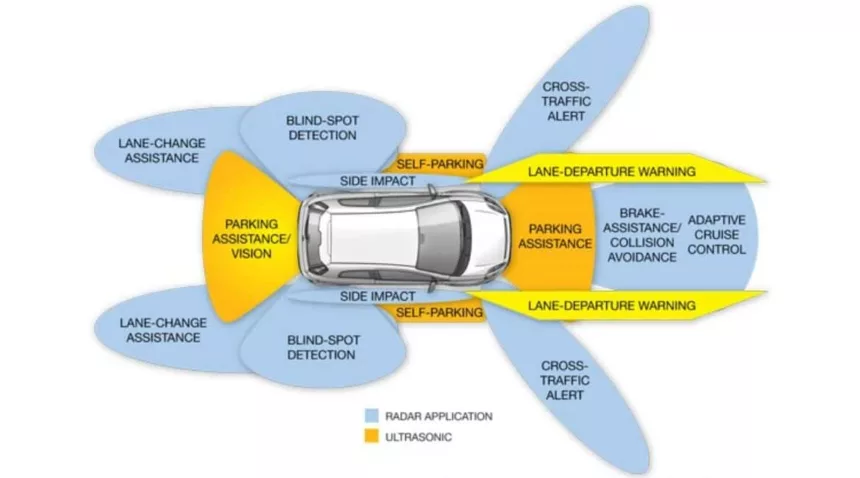The automotive industry has come a long way in terms of safety. In the past, cars were not as safe as they are today, and accidents were much more common. However, with the introduction of new technology and advancements in design, cars are now safer than ever before.
Today, there are a number of must-have car safety features that are available on most new cars. These features can help to prevent accidents and reduce the severity of injuries if an accident does occur.
In this article on IchieTech, we will discuss some of the most important car safety features in modern cars. We will also provide information on how these features work and why they are important.
List of the Must Have Car Safety Features in Modern Cars
Here are some of the must-have car safety features in modern cars:
1. Adaptive Cruise Control (ACC)
Picture this: cruising down the highway, and the traffic ahead suddenly slows down. With Adaptive Cruise Control, your car not only maintains a preset speed but also adjusts it based on the flow of traffic. It’s like having a co-pilot that ensures a safe distance from the vehicle in front of you. How does it work? The system utilizes sensors and radar to monitor the traffic, providing a seamless driving experience.
2. Automatic Emergency Braking (AEB)
Imagine a scenario where a sudden obstacle appears on the road, catching you off guard. Automatic Emergency Braking is a game-changer in such situations. This feature detects an impending collision and automatically applies the brakes if the driver doesn’t react in time. It’s a safety net that significantly reduces the risk of accidents and enhances overall road safety.
3. Anti-lock brakes (ABS)
Anti-lock brakes (ABS) are a system that prevents the wheels of a car from locking up in the event of sudden braking. This can help to maintain control of the car and prevent it from skidding. ABS can be especially important when driving on slippery roads.
4. Lane Departure Warning and Lane-Keeping Assist
We’ve all experienced that momentary lapse of attention when a car unintentionally drifts out of its lane. Lane Departure Warning alerts the driver when this happens, preventing potential side-swiping incidents. Couple this with Lane-Keeping Assist, which gently steers the vehicle back into its lane, and you have a safety duo that minimizes the chances of unintended lane departures.
5. Blind Spot Detection
No more craning your neck or relying solely on your mirrors. Blind Spot Detection is a safety feature that uses sensors to monitor the areas beside and behind your car. If there’s a vehicle in your blind spot, a visual or audible alert warns you, ensuring you make safer lane changes. It’s an extra set of eyes that enhances your awareness on the road.
6. Cross Traffic Alert
Picture this common scenario: you’re backing out of a parking space, and your view is obstructed. Cross Traffic Alert comes to the rescue by monitoring the traffic approaching from the sides. It warns you of any oncoming vehicles, reducing the risk of collisions in parking lots and other tight spaces.
7. Traction Control System (TCS)
Whether it’s a wet road or a slippery surface, maintaining control of your vehicle is crucial. The Traction Control System prevents wheel spin during acceleration by adjusting engine power or applying brakes to specific wheels. This feature ensures optimal traction, especially in challenging driving conditions, enhancing stability and safety.
8. Electronic Stability Control (ESC)
Ever had that unsettling feeling of losing control during sudden manoeuvres? Electronic Stability Control is designed to prevent skidding and loss of control. It automatically applies brakes to individual wheels if it detects a loss of traction, helping you maintain stability and stay on your intended path.
9. Collision Avoidance System
The name says it all – Collision Avoidance System goes beyond warning you of potential collisions; it actively intervenes to prevent them. By combining various sensors and technologies, this advanced safety feature can autonomously steer, brake, or accelerate to avoid a collision. It’s like having a proactive guardian angel for your car.
10. Rearview Camera
Parking mishaps and fender benders while reversing are now a thing of the past. A Rearview Camera provides a clear view of the area behind your car, making parking and manoeuvring in tight spaces a breeze. It’s a simple yet effective addition that enhances safety and reduces the likelihood of accidents.
11. Tyre Pressure Monitoring System (TPMS)
Often overlooked but critical for safety, the Tyre Pressure Monitoring System keeps you informed about the pressure in your tyres. Properly inflated tyres contribute to better handling, fuel efficiency, and overall safety. With TPMS, you receive real-time alerts, ensuring your tyres are always at their optimal pressure.
12. Vehicle-to-vehicle (V2V) communication
Vehicle-to-vehicle (V2V) communication is a technology that allows cars to communicate with each other. This can help to prevent accidents by allowing cars to share information about their location, speed, and direction.
13. Airbags
Airbags are one of the most important car safety features. They are designed to inflate in the event of a collision, providing a cushion of air between the occupants of the car and the hard surfaces of the vehicle. Airbags can help to prevent serious injuries and fatalities.
Conclusion
In conclusion, the evolution of automotive technology has ushered in a new era of safety features that are no longer luxuries but necessities. These must-have safety features in modern cars not only enhance the driving experience but also play a pivotal role in reducing accidents and saving lives on the road. As we continue to embrace technological advancements, it’s reassuring to know that our vehicles are equipped with the latest innovations to keep us safe on our journeys. Drive safe, and enjoy the peace of mind that comes with these indispensable safety features.










